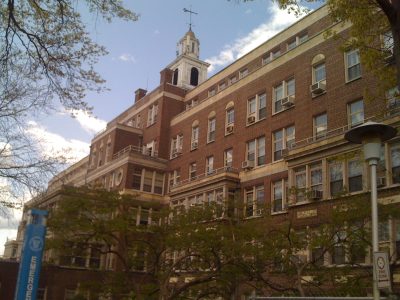NY Medical College Hopes to Replace Building With Student Housing
News Based on facts, either observed and verified directly by the reporter, or reported and verified from knowledgeable sources.

Westchester County and New York Medical College have plans to demolish a building once used to treat tuberculosis patients on the county’s Grasslands campus in Valhalla and build on-site housing for medical students.
The county, which owns the land, would demolish the vacant four-story Munger Pavilion, and the college would build the residential hall at its own cost, said Dr. Edward Halperin, the chancellor of New York Medical College and a pediatric radiation oncologist. The building is situated on a parcel of about 55 acres of county land.
Halperin said the 95-year-old building, which is steadily decaying, no longer serves a purpose for the college. Plus, there’s a critical need for student housing close to the school. About 220 students attend the medical school, but there are also the School of Dental Medicine and the School of Health Sciences.
Munger Pavilion, named for Dr. Claude W. Munger, who was the director of Grasslands Hospital, the forerunner to Westchester Medical Center, in the 1920s and ‘30s, was no longer needed once the college moved some of its operations to Skyline Drive in Hawthorne, according to the college.
Halperin said at the time of the pavilion’s construction “the management of tuberculosis was rest, fresh air, sunshine and prayer.”
“There’s nothing in there anymore that you can’t show medical students with photographs,” Halperin said. “Yeah, there are a lot of spit basins, there is a lot of tile floor to be cleaning up the mess. There’s no educational value.”
He and Dr. Robert Amler, New York Medical College’s dean of the School of Health Practices, appeared before the Mount Pleasant Town Board last week to discuss the college’s aspirations and keep town officials up to date on any future plans.
While there are no concrete plans yet, Halperin said the administration is looking at a building that is no larger than the Munger Pavilion containing about 250 units with about 300 to 350 beds. There would probably be mostly single units, but also some doubles for students who want to cut costs, he said. About three-quarters of medical students in the U.S. fund their education with loans.
Finding housing for medical and dental students has become a challenge since the campus can’t accommodate them and the price of area housing is prohibitive, adding to the students’ total expenses in addition to tuition.
“The majority of the students, they want to roll out of bed and walk across the street to the class,” Halperin explained. “They do not want to get in a car.”
There would also be study areas, a prayer room and space for the chaplain, he said.
Town Board members questioned whether the housing could generate schoolchildren for local schools, in this case the Pocantico Hills School District. Halperin said today there are very few medical or dental students who are married with children. He estimated that at any given time there could be up to three to five children of school age.
Halperin said the demand for on-campus housing among students is so great that it is unlikely that any of the units would be vacant for long. If that were to happen, the college could rent out units to residents and interns at the medical center, he said.
Supervisor Carl Fulgenzi said he wondered if there was anything of historical value that could be lost if the building would be demolished. Other than “a historic feeling,” that would not be the case, Halperin mentioned. Whatever structure is built for student housing, could be made to resemble the current building, including the addition of a cupola on the roof.
Halperin estimated that if the plans were to go forward, demolition would likely take six months to a year while construction could take three to four years. There is asbestos in Munger Pavilion, which would elongate its demolition because of required remediation.
There should also be no disturbances from the higher concentration of students on campus, compared to an undergraduate school.
“Medical students and dental students, they go to class, they go to the library and they go to bed,” Halperin said. “That’s what they do. No one’s going to get kicked out of medical school when there are 12,000 applications for 220 spots.”
Currently, 45 years remain on the college’s lease with the county. If the student housing is built, that would be extended to 99 years, Halperin said.

Martin has more than 30 years experience covering local news in Westchester and Putnam counties, including a frequent focus on zoning and planning issues. He has been editor-in-chief of The Examiner since its inception in 2007. Read more from Martin’s editor-author bio here. Read Martin’s archived work here: https://www.theexaminernews.com/author/martin-wilbur2007/
